Novak Djokovic defeated Stefanos Tsitsipas 6/3 7/6 7/6 in the final of the Australian Open to lift his 22nd major title and draw level with Rafael Nadal. The Serb is now a perfect 10-0 in AO finals and extends his H2H over Tsitsipas to 11-2 (Djokovic has now won the last 9 encounters).
In the AO Final Preview, I made the case that Tsitsipas would have to dominate with his forehand, as his backhand was a defensive liability without a great slice. Early in the encounter, with the Serb up a break, the commentators mentioned this stat of Tsitsipas’ AO campaign:
“Whenever he [Tsitsipas] hits two backhands in a rally he wins just a third of the points.”
“That’s scary. Those are stats you don’t want to hear.”
The Tsitsipas inside-in/cross-court forehand is his best shot. It protects his backhand and attacks the (usually) weaker defensive side in men’s tennis. Whenever Tsitsipas got enough width to break the Djokovic forehand singles sideline, he was in a good position to win the point:
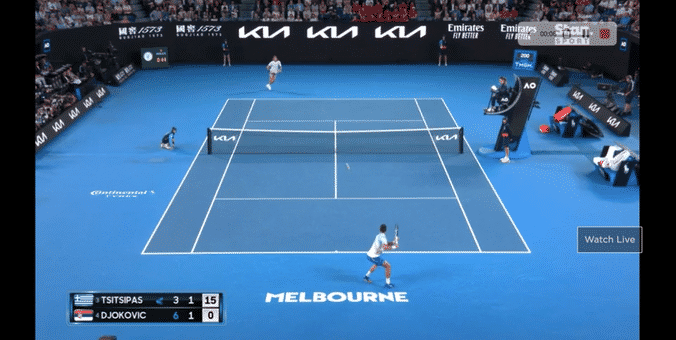
The problem is that Djokovic does such a good job of not only neutralizing the Tsitsipas first serve with his own well-struck returns, but during forehand exchanges he was more than capable of trading forehand plays with pace equal to, or greater than, Tsitsipas’ own forehand.

Some excerpts from the commentators in the early stages of the match:
“I just think that Novak is the best, actually the best of all the guys of targeting a weakness and staying to that position throughout the entirety of the match. I expect to see that repeated a lot tonight.”
“I just feel that Tsitispas can’t hurt Novak with these sedate evening conditions.”
“With his [Djokovic’s] depth and pace of shot you just lose time. It makes it very difficult, as the scoreboard is showing us.”
Midway through the match an infographic of backhand depth backed up this last comment:

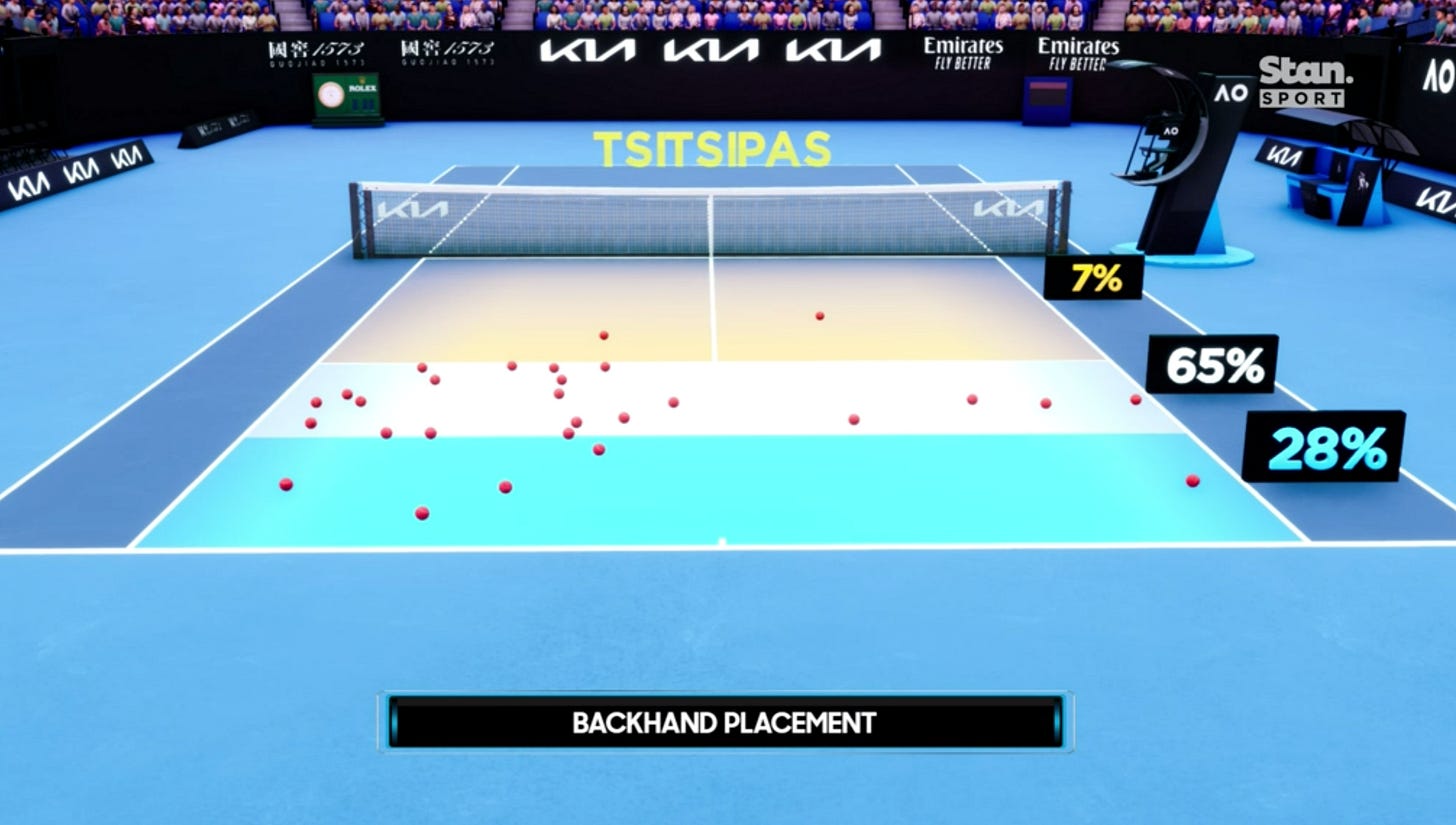
The backhand line is a shot/pattern that the Greek just doesn’t have (to Tsitsipas’ credit he did pull off some nice backhand’s down-the-line late in the piece, but this was throwing caution to the wind; it’s just not a percentage play for him like it is for Djokovic). In contrast (and very similar to his start against Tommy Paul in the semis) Djokovic pulled the trigger early in the match on this play.
Keep in mind Djokovic maintained far superior backhand depth and change-of-direction yet still maintained a relatively good backhand ‘winner to unforced error’ ratio. A look at the official statistics:
Tsitsipas’ forehand went from +12 in his semi-final match v Khachanov, to -16 (!) tonight against the Djoker. Khachanov chipped a lot of forehand returns that gave Tsitsipas time. Tonight there was no such respite, and it was Djokovic who hit more forehand winners by virtue of having a change-of-direction backhand that opened up the court:

An excerpt from the preview:
“For Djokovic, Sunday demands an ordinary performance on a special day. His bread-and-butter level will win this match in 3 or 4 sets. His serve is like his baseline game now; too slow to register a mountain of aces, but too accurate and just fast enough to pile up a huge percentage of unreturned serves or easy short balls. And of course, his ability to take the ball line with depth is going to give him too many free points and too many looks at short balls”
One important point that I think is indicative of the “Nextgen’s” inability to seize big match wins over the Big-3 is to do with pressure points. Tsitsipas took this match to two tie-breakers, and in both his forehand completely fell away:
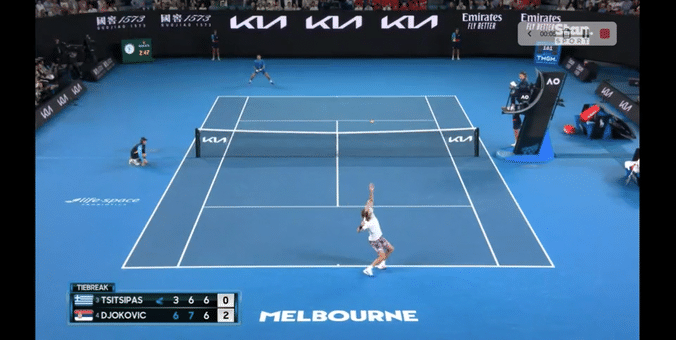
And I think this below statistic is telling not just for Tsitsipas, but for the horde of Nextgen talent that are anointed as potential great players because of huge serves and forehands:
Everyone talks of the weapons and power of the youngsters, but the reason why I think Djokovic is so great is all to do with control. When the pressure rises, the instinct is to play safer, the rallies extend, and this safer style nearly always favours Djokovic because his whole game is geared around control and absorption; absorption of pace and pressure. I echoed similar thoughts after Djokovic’s triumph over Kyrgios at Wimbledon last year:
“One of the hardest things about playing Djokovic is the difficulty of winning important points. As the occasion grows, the style of tennis of most players converges towards the safe and consistent style that Djokovic epitomizes, and so solving the Djokovic game presents players with a puzzle; as you get closer to beating him, you instinctively tend to improve his odds of winning points, and kill your own.”
But don’t take my word for it. A brilliant piece from Matt Willis' The Racquet with the average breakdown of points is as follows1:
0-4 shots: 65% of points
5-8 shots: 27% of points
9+ shots: 8% of points
However, Matt goes on to mention (emphasis mine):
“But something really interesting happens if we isolate the pressure points i.e all breakpoints (both the BP creator & defender), 30-All, deuce points, AD-40 or 40-AD, all tiebreak points, and 0-30 on serve:”
0-4 shots: 57% of points (-8%)
5-8 shots: 33% of points (+6%)
9+ shots: 10% of points (+2%)
In big moments clutch tennis is about being able to control the tennis ball with nerves in extended rallies. Playing up in the court with the whippy strokes endemic in youngsters is just a tough ask under pressure. Interestingly, Tommy Paul’s coach, Brad Stine, mentioned this during the match:
“There was one player with a one-handed backhand that at his peak was one of the few players that could take on the Big-4 at their very best.
“Stan the Man [Wawrinka]”
“Two of the greatest performances you will ever see. Roland Garros in 2015 and the US Open in 2016.”
Brad Stine: “I think that’s interesting because one of the things I tried to get Tommy Paul to do the other night during the match was give a little bit of extra ground. Wally mentioned earlier the depth Novak plays with on a consistent basis. I tried to get Tommy to give up a little extra ground to make full swings at the ball.”
I think Stine was correct in the strategy; you need to stand a little deeper to handle Djokovic’s constant depth. If we look at the non-Big-3 players who have beaten him deep in slams—Medvedev, Wawrinka, Thiem, and Murray—they all have an ability to play their game from a few metres behind the baseline. As Mark Woodforde acknowledges after this blistering Wawrinka forehand winner from their 2016 French Open final:
“Look at the distance he [Wawrinka] is behind the baseline. This is the ability of the Staminator.”
Peak Wawrinka ~2013 onwards was nearly always a problem for Djokovic at slams because of the match-up: Stan had a great block return and Djokovic doesn’t quite have the dynamic forehand of Federer or Nadal to take advantage of that on the +1 shot. Then, during rallies, Wawrinka stood deep and had enough fire power from both wings to hit winners from well behind the baseline. Of course, he used a hammer of a stick (375 grams, 360 SW) with a high-noon takeback and an extended wrist on the forehand.2
Such weight in the racquet would also be hugely beneficial when blocking and controlling first-serve returns back deep; something Tsitsipas is sorely lacking. A few excerpts from Technical Tennis: Racquets, Strings, Balls, Courts, Spin, and Bounce, by Rod Cross and Crawford Lindsey (emphasis mine) for your consideration:
“Weight and weight distribution are the most important racquet properties with respect to performance. The reason is that they, more than any other characteristics, determine the flow of energy when the racquet and ball collide. Together they determine how much the racquet will be pushed backwards, rotate, and twist on ball impact. The greater the effective weight at the impact point (hittingweight), the less these events will occur. And the less these occur, the more energy will be used moving the ball instead of the racquet. That means more power. It also means more control.”
“If a heavy and a light racquet are each swung at the same speed, the ball will come off the heavy racquet faster because the heavy racquet has more momentum and more energy that it can transfer to the ball, and it will lose less energy. However, heavy racquets might not be swung as fast as light racquets. There is, therefore, not a big difference in maximum power between heavy and light racquets. In general, racquets tend to be swung at medium to fast pace rather than maximum possible speed because players need to make sure the ball goes in. In that case heavy racquets offer a bit more power and control than light racquets because they don’t need to be swung as fast to achieve the same ball speed.”
But I digress.
In summary, Tsitsipas needs a slice if he is to really become a complete player on hard courts. Djokovic now returns to world number 1 on Monday, and there is still daylight between him and the chasing pack with Nadal’s body increasingly failing him. Playing with such control and determination, the slams for the rest of the year all seem very much in reach if he can show up and stay fit.
That concludes a pretty hectic month of tennis! I’ll be back with some notes later in February.
Matt acknowledges the data source: “Thanks to Shane Liyanage for these and the figures below, taken from the Data Driven Sports Analytics database — sample size 2000+ matches.”
For reference, Djokovic’s racquet is reportedly 357g and 364SW. Tsitsipas is 334g 343SW.
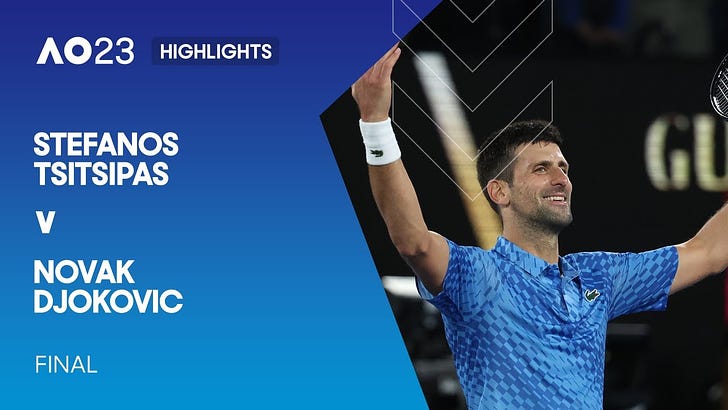



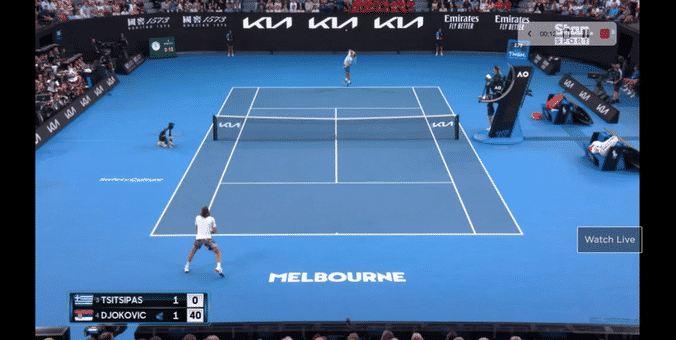
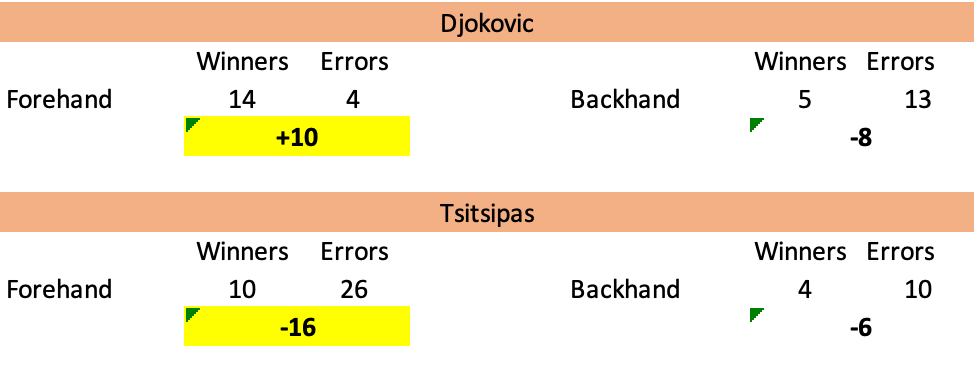


Great article and very thought provoking, but how would the slice have helped tsitsipas here?
Tsitsipas needs a better slice, I agree, but doubt that would have helped him. But what about his serve toss and motion? For a guy with such fluid groundstrokes and volleys, his serve looks awkward, even ugly.